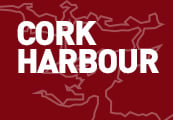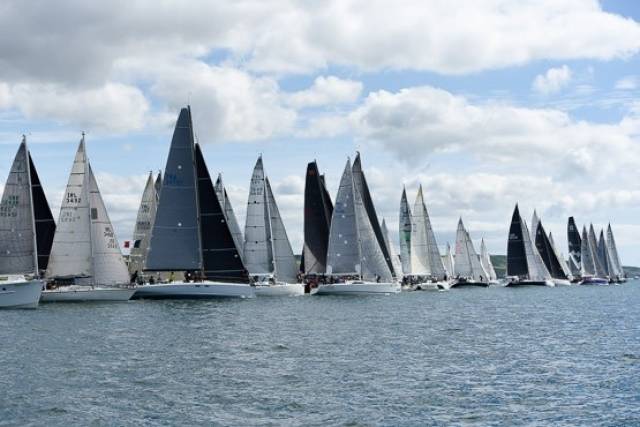Afloat.ie’s W M Nixon won’t divulge when he first sailed into Cork Harbour, but he claims to have taken part in an early version of Cork Week as long ago as 1970. And he also claims that, at the Week of 1992, when ashore he never went beyond the RCYC’s Regatta Compound. He was overnighting aboard his boat which was a competitor, and after racing the whole sailing world and all facilities were to be found right there in the compound. There was no need to go any further. Here, he casts an eye over Volvo Cork Week 2016, and reflects on the extraordinary story of the hosting club.
There was a time when most histories of sailing were based on the idea that yachting as we know it didn’t really begin until 1815, when the final defeat of Napoleon at the Battle of Waterloo provided peaceful seas off Europe to allow recreational sailing to develop into what ultimately became many forms, involving boats and rigs of all types.
It’s a process which continues today. But while the change in circumstances in 1815 was undoubtedly a major force in accelerating the development of the sport, anyone in Cork will be only too happy to tell you that by the time of Waterloo, the Water Club of the Harbour of Cork had been in existence for all of 95 years.
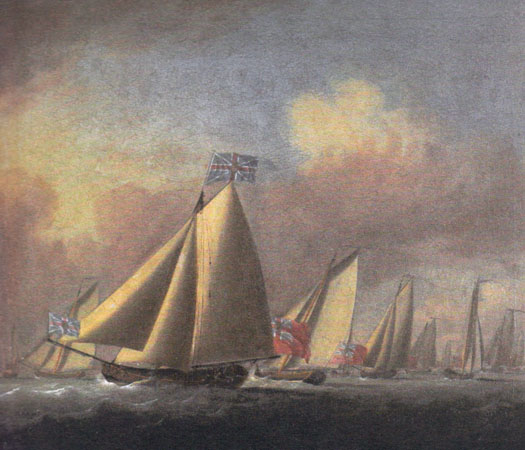 The great pioneers. The yachts of the 1720 Water Club of the Harbour of Cork, as recorded by Peter Monamy in 1738. Courtesy RCYC
The great pioneers. The yachts of the 1720 Water Club of the Harbour of Cork, as recorded by Peter Monamy in 1738. Courtesy RCYC
And up Athlone way, they’ll determinedly assert that Lough Ree YC came into being in some form or other in 1770, so it was looking at 45 years by the time of Waterloo. But on Lough Ree, you could be reasonably confident that your day’s sailing wouldn’t be spoilt with an attack by French privateers. Yet the Privateer threat was a fact of life in the seas off Cork in the turbulent times as the 1700s drew to a close, and the cheekier ones even came right into Cork Harbour itself.
Nevertheless although the 1720-founded Water Club had a tenuous-enough existence at times, as soon as peace broke out it reasserted itself, a notable instance being in 1802 after the Peace of Amiens, and again in 1806 when the Battle of Trafalgar in 1805 had greatly reduced the French threat at sea.
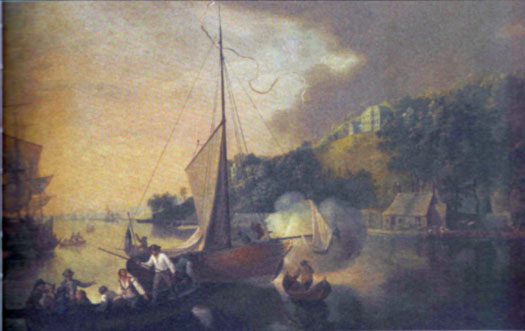 The quiet years. A lone yacht of the Water Club shown in a panting by Nathanael Grogan in the upper harbour of Cork at Tivoli in the late 18th century
The quiet years. A lone yacht of the Water Club shown in a panting by Nathanael Grogan in the upper harbour of Cork at Tivoli in the late 18th century
With each revival, names of “Old Members” would be added to the lists of new people who wished to keep the club going. And though there may have been times when Annual General Meetings weren’t held – a requirement for any club’s continuing validity today – the old Water Club always seems to have been part of the warp and weft of the great fabric of Cork Harbour, where they’d a much more relaxed attitude to the necessity for an AGM in the dim and distant past.
It became the Royal Cork Yacht Club in 1830 when sailing was being re-structured at national level, and it was always enumerated as Club No 1 in the official listings, even if the Royal Yacht Squadron tended to be listed above it. Yet if you were at the opening party of Volvo Cork Week at the Royal Cork in Crosshaven last Sunday evening, you could have been forgiven for thinking that this was a happening being organised by the newest club on the block.
The fact is the Royal Cork is not merely ageless – it is eternally young. In this era of outdoor festivals, at events like Sunday’s opening party they showed themselves ahead of the curve in having world-standard sound systems which provide a welcome and easily-audible intimacy for speakers, enabling them to put through an informative programme of crisp speeches in comfortable time as the party buzz built steadily among the gathered multitude, whose friendly attention was duly rewarded by the arrival of a sunny evening.
The atmosphere was of one great big happy family gathering. And if this seemed to be a family with many members holding high military rank with decorations to match, it’s because the occasion was taken to launch the Beaufort Cup in all its official glory, and there were more naval and other military attaches present than you’ll see at many a National Day parade.
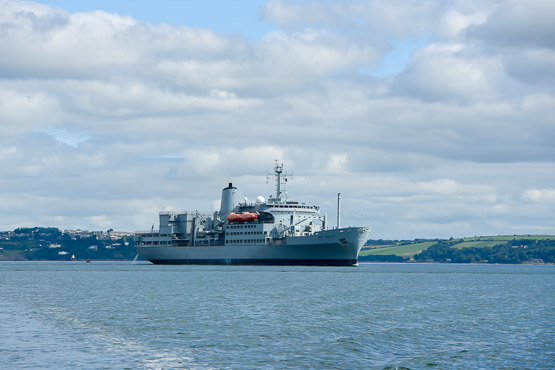 Naval presence. The successful staging of the first Beaufort Cup series within Volvo Cork Week 2016 saw increased naval activity in Cork Harbour, including this Royal Navy Supply Ship. A highlight of the Beaufort Series was a black-tie dinner for all competing crews in the Naval Base on Haulbowline Island on Tuesday night. Photo: Bob Bateman
Naval presence. The successful staging of the first Beaufort Cup series within Volvo Cork Week 2016 saw increased naval activity in Cork Harbour, including this Royal Navy Supply Ship. A highlight of the Beaufort Series was a black-tie dinner for all competing crews in the Naval Base on Haulbowline Island on Tuesday night. Photo: Bob Bateman
But far from parading military might, the Beaufort Cup is all about comradely sailing competition, providing sport afloat for people who normally look on being at sea in a very different light. And it was not just between people in the armed forces, but between agencies of all kinds – life-saving, fisheries supervision, port inspection or whatever – where I suppose the only common denominator is that at some stage the people involved might wear a uniform.
The trophy commemorates Meath-born Admiral Sir Francis Beaufort (1774-1857) whose achievements in hydrography and marine science were many. The idea of commemorating him in this way certainly captured the Volvo Cork Week imagination, with people readily making their boats available to agency crews who did not have access to craft of their own.
The spirit of it all was exemplified by the first boat and crew to the Fastnet Rock in the Beaufort’s long opening race. It was Conor Doyle of Kinsale’s X442 Freya, crewed by the Police Service of Northern Ireland. And then the overall winner of this special Fastnet race on corrected time was John Maybury of Dun Laoghaire’s champion J/109 Joker 2, sailed by an Irish Defence Forces crew skippered by Commandant Barry Byrne.
Barry Byrne and his crew on Joker 2 continued their success through the week as the varied fleet was put through a programme of equal variety, and it was singularly ironic that Class 0 in the Combined Fleets Harbour Race for the Hugh Coveney Trophy – surely the ultimate combination of a sailing come-all-ye and a festival of local knowledge – should be won by Eric de Turckheim’s A13 Teasing Machine, which is rightly recognised as one of the greatest offshore racers currently active on the planet, but arguably not a boat the smart money would have backed to win her class in a crowded race in the winding waters of Cork Harbour.
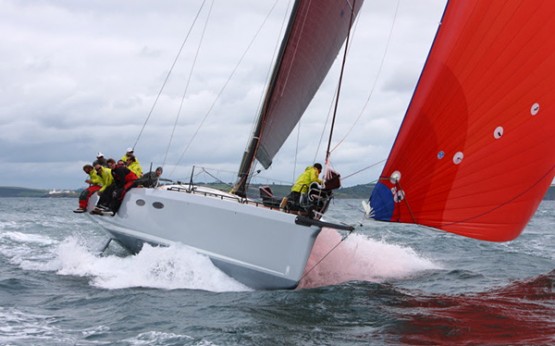 Teasing Machine revelling in a breeze at the start of the week. Yet she won Class 0 in lighter airs in the Harbour Race. Photo: Tim Wright
Teasing Machine revelling in a breeze at the start of the week. Yet she won Class 0 in lighter airs in the Harbour Race. Photo: Tim Wright
And as for the alleged benefits of local knowledge, perhaps the Cork sailors were being just too clever in using their supposed experience in the weird ways of the tides and winds within this historic natural harbour, for the overall winner of the Harbour Race was Charlie Frieze’s Mills 36 Prime Suspect from Scotland, which made a good start in clear air, and continued to build on it.
In a sense, it was a double victory, as the breeze freshening towards the end naturally favoured the smaller boats over those already finished, despite Tony Langley’s TP52 Gladiator having zapped round the course in less than two hours. But although Prime Suspect was clearly mid-fleet in size, she put in such a neat showing she stayed ahead of Quarter Tonners and the like to take the prize.
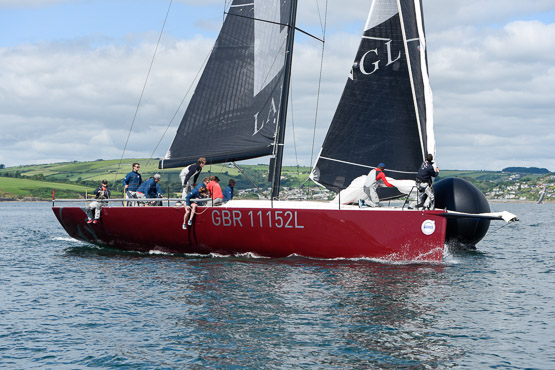 Tony Langley’s TP52 Gladiator took line honours in the Harbour Race. Photo: Bob Bateman
Tony Langley’s TP52 Gladiator took line honours in the Harbour Race. Photo: Bob Bateman
In fact, the view that smaller boats would be favoured by the freshening breeze doesn’t really stand up to examination, as second overall was taken by Richard Matthews’ new H39 Oystercatcher XXXI, a notably handsome boat in a very distinctive shade of blue. And as for assertions that an excess of local knowledge can sometimes be a drawback, Oystercatcher XXXI proved otherwise, as her crew included Eddie English who probably knows more of the sailing ways and wiles of Cork Harbour than anyone else on the planet.
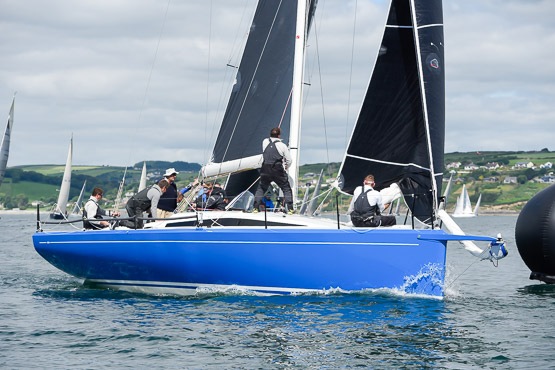 A bit of local knowledge didn’t go amiss…..with Eddie English of Cobh on board, Richard Matthews’ new Oystercatcher XXXI took second overall in the Harbour Race. Photo: Bob Bateman
A bit of local knowledge didn’t go amiss…..with Eddie English of Cobh on board, Richard Matthews’ new Oystercatcher XXXI took second overall in the Harbour Race. Photo: Bob Bateman
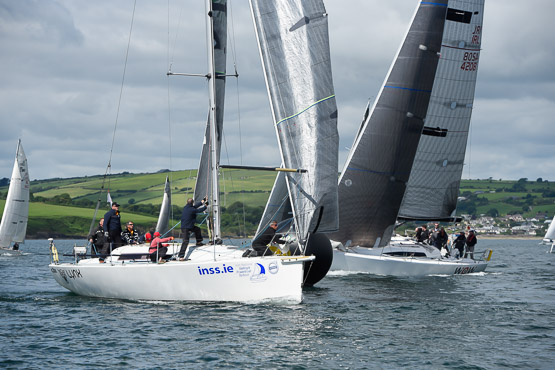 An unrivalled learning environment – the Irish National Sailing School of Dun Laoghaire’s Reflex 38 Lynx in action in Cork. Photo: Bob BatemanThird slot overall went to John Swan’s Half Tonner Harmony from Howth, continuing her dominance of Class 3 where she’d already logged six bullets in eight races by the time they took on the points-free harbour melee.
An unrivalled learning environment – the Irish National Sailing School of Dun Laoghaire’s Reflex 38 Lynx in action in Cork. Photo: Bob BatemanThird slot overall went to John Swan’s Half Tonner Harmony from Howth, continuing her dominance of Class 3 where she’d already logged six bullets in eight races by the time they took on the points-free harbour melee.
Whether sailing for fun in the Harbour Race, or competing with a real edge for points gains in races included in the European IRC Championship, there can be absolutely no doubt that this Volvo Cork Week is all about high-pitched racing, and as such is light years away from the Admiral Sailing in formation which was at the core of the sea-going activities of the Water Club in its early days.
Or is it? At mid-week I’d a very amiable discussion with Royal Cork YC archivist Dermot Burns as to whether or not the original Club of 1720 included racing in its activities. He reckons a form of competitive sailing - beyond that of showing your ability to maintain station relative to the Admiral while moving along in formation - is suggested in the Sailing Orders which were re-published in 1765 after the club had gone through one of its regenerations in 1760, though it does involve assuming that the Orders of 1765 reflected the original orders of 1720.
The many orders are un-numbered, but down around what would be number 17 we find:
“WHEN the Admiral will have the whole Fleet to Chace, he will hoist Dutch colours under his Flag, and fire a Gun from each Quarter; if a single boat, he will hoist a Pendant, and fire as many guns from the side as the Boat is distanced from him. WHEN he would have the Chace given over, he will hawl in his Flag and fire a Gun”.
Dermot’s very reasonable contention is that “Chace” is in the same sense as Steeplechasing for horses, and that these are straightforward orders for either fleet races or a match race, the start simply being made by piling on the speed from whatever position you’re in when the Admiral gives his signals.
It’s a long way from today’s precisely-laid committee boat starting lines. And it boggles the mind to think of your average modern crew trying to decide what Mr Big means when he starts firing guns from every quarter and sending all manner of flags aloft. But it’s part of the joy of studying the long history of the Royal Cork Yacht Club that such gems for interpretation come our way.
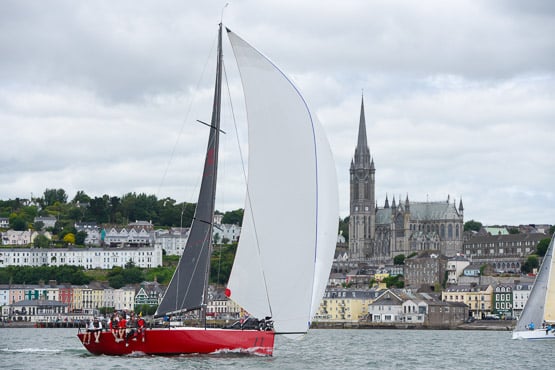 Admiral’s orders? Former RCYC Admiral Anthony O’Leary racing top contender Antix off the Cobh waterfront. Photo: Bob Bateman
Admiral’s orders? Former RCYC Admiral Anthony O’Leary racing top contender Antix off the Cobh waterfront. Photo: Bob Bateman
And who knows, but with further tangential study it may still be possible to find out who actually won those earliest races. For though we soon find notices of a up-coming races of the Water Club being advertised in the local press, accounts of what actually happened, if they appear at all, can be confused in the extreme as the reporter is often too giddy with listing the names of the great and the good who are present, and how fashionable the gathering is, to give us the hard facts of yacht race results.
Meanwhile, Dermot was also able to put me right on the notice advertising the forthcoming Water Club Race of 1787 as entitling the winner to an Anchor. Far from being a complex right to decide where the fleet should anchor, the word is that an Anchor is a substantial measure of brandy. I should have known that.
Some histories can evoke happy memories combined with entertaining and friendly debates among friends. Such is the story of the Royal Cork Yacht Club. And with the prospect of the RCYC 300th Anniversary in 2020 coming steadily down the line, the good news is that there was across-the-board political representation at a very high level at the Crosshaven events on Sunday July 10th. So much so, indeed, that it’s reasonable to expect that whatever government is in power in 2020, there’ll be proper official support for the celebration of this unique Tricentenary for an ever-young club which could only have been founded in Ireland, and only in Cork at that.
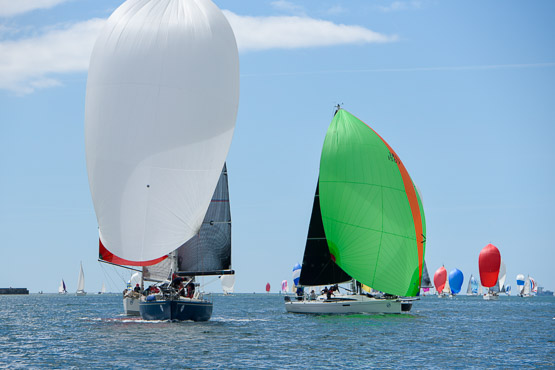 At last! The summer comes in from the sea at Volvo Cork Week 2016. Photo: Bob Bateman
At last! The summer comes in from the sea at Volvo Cork Week 2016. Photo: Bob Bateman


